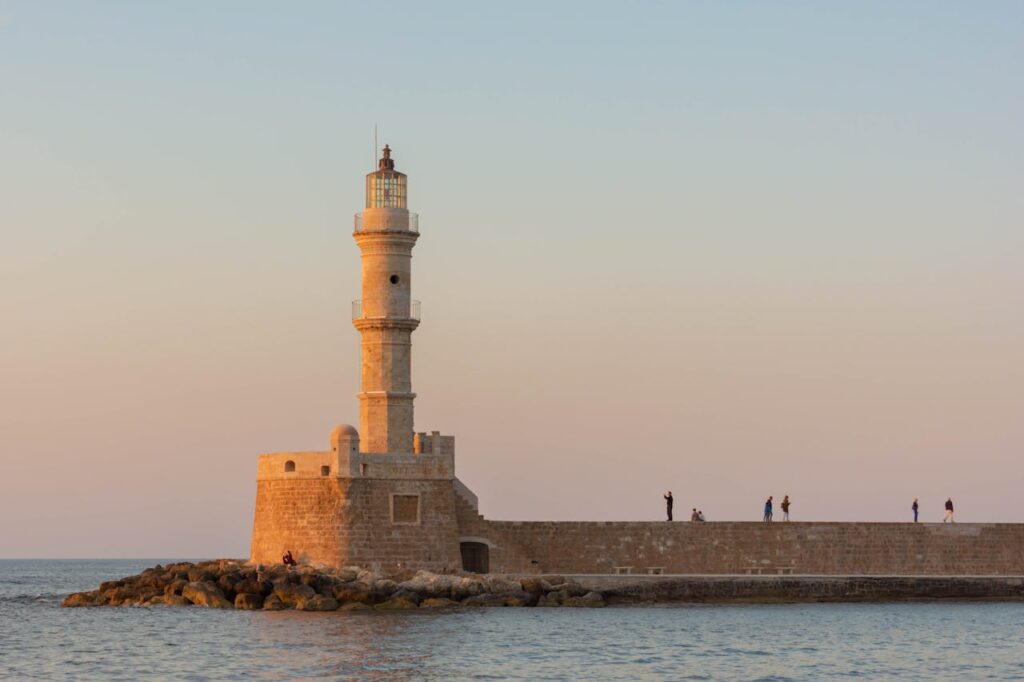
Explore & Play
Discover interesting topics and solve the accompanying crossword puzzle.
Lighthouse Crossword | Discover Coastal Beacons
Explore the lighthouse crossword and uncover fascinating coastal beacons around the world. Learn about iconic lighthouses and their rich histories.
Table of Contents
Welcome to our exciting exploration of coastal beacons! You can start by playing the Lighthouse crossword to test your knowledge of these iconic structures. If you’re not familiar with the topic, feel free to read the article first and then return to enjoy the crossword. Whichever path you choose, we hope you find both the puzzle and the article enlightening and enjoyable.
Lighthouse Crossword
You can either fill in the crossword puzzle directly on this page or click the button in the bottom right corner to print it for free.

Around the World in Lighthouses: Iconic Coastal Beacons and Their Stories
Lighthouses have stood as guardians of the sea for centuries, guiding sailors through perilous waters and illuminating the night skies. These iconic structures, perched along the world’s coastlines, have become more than just navigational aids—they are symbols of resilience and history. In this article, we’ll embark on a journey across the globe, exploring 50 of the most famous lighthouses, each with its own unique story. And if you’re a fan of puzzles, don’t miss our lighthouse-themed crossword!
The Role of Lighthouses in Maritime History
Lighthouses have served as crucial navigational aids for centuries, guiding ships safely through treacherous waters and hazardous coastlines. Their primary role is to emit light, often in distinct patterns, that helps mariners identify their location and navigate safely. The earliest lighthouses, like the famous Pharos of Alexandria, were monumental structures that not only provided light but also showcased architectural ingenuity. Historically, lighthouses have played a pivotal role in the development of trade routes and the expansion of maritime commerce. Before modern navigation technology, sailors relied heavily on these beacons to avoid shipwrecks and to find safe passage into busy ports. The strategic placement of lighthouses along coastlines was essential in ensuring the safety of vessels and, by extension, the economies that depended on maritime trade. Lighthouses have also witnessed significant historical events, from maritime battles to the discovery of new lands. Many have served as lookout points during wars, providing essential information about approaching fleets. Additionally, lighthouses often functioned as vital communication hubs, with signal flags and sound signals used to convey messages to ships at sea. Today, while advanced GPS and digital navigation systems have reduced the reliance on lighthouses, their historical significance and romantic allure remain. Many lighthouses have been preserved as cultural landmarks, embodying the spirit of maritime exploration and serving as a testament to humanity’s relationship with the sea.Exploring the Lighthouses of Europe
Europe boasts some of the most iconic and picturesque lighthouses, each with its unique history and architectural style. From the rugged coastlines of Scotland to the sun-drenched shores of the Mediterranean, lighthouses dot the landscape, telling stories of resilience and navigation. One of the most famous is the Tower of Hercules in Spain, a Roman lighthouse that still stands tall after nearly 2,000 years. It is recognized as a UNESCO World Heritage Site and remains an important navigational landmark. Similarly, the Eddystone Lighthouse in England, built in the 18th century, is renowned for its innovative design and has become a symbol of maritime safety. In Scandinavia, lighthouses like Kullen Lighthouse in Sweden and Bølgernes Fyr in Norway showcase the region’s commitment to maritime safety. These lighthouses not only guide vessels through perilous waters but also serve as popular tourist attractions, offering breathtaking views of the surrounding landscapes. Additionally, many European lighthouses have been converted into museums or bed-and-breakfasts, allowing visitors to experience maritime history firsthand. For example, the Pigeon Point Lighthouse in California, though not in Europe, has similar counterparts in Europe where guests can stay overnight in a historic lighthouse, immersing themselves in the rich maritime heritage.Lighthouses of the British Isles: Icons of the Coast
The British Isles are home to some of the most renowned lighthouses in the world, each serving as a symbol of the region’s rich maritime history. With rugged coastlines and treacherous waters, these beacons have been essential for navigation and safety for centuries. One standout example is the St. Abbs Head Lighthouse in Scotland, perched dramatically on a cliff overlooking the North Sea. Its striking location and historical significance make it a beloved landmark for both locals and visitors. Similarly, the Trevose Head Lighthouse in Cornwall is celebrated for its beautiful architecture and stunning coastal views. The Isle of Skye is another notable location, featuring several lighthouses, including the Neist Point Lighthouse, which offers breathtaking panoramas of the surrounding landscape. The unique interplay of light and shadow created by these lighthouses has inspired countless artists and photographers. Many lighthouses in the British Isles are steeped in folklore and maritime legends, adding an element of mystique to their already fascinating histories. For instance, the Lindesnes Lighthouse in Norway, which has been guiding ships since the 17th century, is said to be haunted by the spirits of sailors who met their fate at sea. As tourism has increased, many lighthouses have become popular destinations, offering guided tours, visitor centers, and even opportunities to climb to the top for spectacular views. The lighthouses of the British Isles continue to stand as icons of the coast, celebrating the rich maritime heritage that has shaped the region’s identity.Mediterranean Lighthouses: Ancient and Modern Marvels
The Mediterranean Sea, with its rich history of trade, exploration, and maritime navigation, is home to numerous lighthouses that embody both ancient traditions and modern engineering. These lighthouses have long been essential in guiding sailors through its often turbulent waters, showcasing the blend of historical architecture and contemporary design. One of the most iconic ancient lighthouses in the Mediterranean is the Pharos of Alexandria, built in the 3rd century BC on the small island of Pharos near Alexandria, Egypt. Although the original structure no longer exists, it was one of the Seven Wonders of the Ancient World and served as a model for future lighthouses. The ingenuity of its design, featuring a three-tiered tower that rose over 100 meters high, influenced lighthouse construction across the Mediterranean and beyond for centuries. In contrast, modern Mediterranean lighthouses incorporate advanced technology while retaining their aesthetic charm. The Cap de Formentor Lighthouse in Mallorca, Spain, is a prime example. Perched on a rugged cliff, it not only provides critical navigation aid but also offers stunning panoramic views of the coastline and the surrounding sea. Constructed in 1863, it combines traditional architectural elements with contemporary lighthouse technology, including automated light systems. Other notable examples include the La Coruña Lighthouse in Galicia, Spain, also known as the Tower of Hercules, which has been a beacon for ships since Roman times. Its blend of historical significance and modern functionality makes it a UNESCO World Heritage Site, attracting countless visitors each year. As tourism has grown, many Mediterranean lighthouses have become popular attractions, offering tours, museums, and restaurants. Visitors can explore the history of maritime navigation while enjoying breathtaking views, experiencing firsthand the legacy of these ancient and modern marvels.North American Beacons: Guiding Ships Through Stormy Seas
North America’s coastlines are dotted with lighthouses that have historically played a crucial role in guiding ships safely through some of the most challenging maritime environments. From the icy waters of Alaska to the warm coasts of Florida, these beacons have withstood the test of time and elements, serving as guardians of the seas. One of the most famous lighthouses is the Cape Hatteras Lighthouse in North Carolina, renowned for its distinctive black-and-white spiral pattern. This lighthouse stands as a testament to resilience; it was relocated in 1999 to protect it from the encroaching sea, demonstrating the ongoing commitment to preserving maritime history. Built in 1870, it is the tallest brick lighthouse in the United States and has guided countless ships through the perilous waters of the Atlantic Ocean, known for its challenging conditions and shipwrecks. The Point Reyes Lighthouse in California is another notable example, situated on a rugged cliff overlooking the Pacific Ocean. Established in 1870, this lighthouse has weathered numerous storms and fogs, serving as a vital point of reference for sailors navigating the treacherous waters of the San Francisco Bay. Visitors to Point Reyes can explore the lighthouse and learn about its fascinating history, including its role in shipwreck prevention. Further north, the Lighthouse at Peggy’s Cove in Nova Scotia, Canada, is an iconic image of Canadian maritime culture. Perched on granite rocks, this picturesque lighthouse has become a symbol of the area and a popular tourist destination. Its striking red and white design contrasts beautifully with the surrounding landscape and offers visitors a glimpse into the history of the region. North American lighthouses are not just navigational tools; they are also cultural landmarks that tell stories of bravery, survival, and the enduring relationship between humanity and the sea. Many of these lighthouses have been restored and converted into museums or visitor centers, where guests can learn about their history and the challenges faced by lighthouse keepers.South American Lighthouses: Navigating Remote Coasts
South America, with its extensive and often rugged coastline, features numerous lighthouses that have historically guided mariners through its remote and sometimes perilous waters. From the icy shores of Patagonia to the tropical beaches of Brazil, these lighthouses tell stories of navigation, exploration, and maritime heritage. One of the most notable lighthouses is the Faro San Juan de Salvamento, located at the eastern tip of Argentina. Known as the “Lighthouse at the End of the World,” it is famously referenced in Jules Verne’s novel of the same name. This lighthouse marks the entrance to the Beagle Channel and has long been a vital navigational aid for ships traversing these challenging waters. Its isolation and dramatic scenery make it a symbol of human determination in the face of nature’s vastness. The Lighthouse of Cabo Blanco in Peru, also known as the Cabo Blanco Lighthouse, stands out for its historical significance and beautiful location. Situated near one of the most popular fishing spots in the country, this lighthouse guides fishermen and vessels navigating the waters of the Pacific Ocean. Its vibrant white structure contrasts with the blue sky and sea, making it a striking landmark along the coast. In Brazil, the Farol do Maranhão serves as an essential beacon for maritime traffic in the São Marcos Bay area. Built in the 19th century, it continues to be an important reference point for boats entering and leaving the bay. The lighthouse’s architecture reflects the colonial style, and it has become a cultural symbol for the region, representing the blend of maritime history and local heritage. Many South American lighthouses are not only functional but also tourist attractions, drawing visitors who wish to explore their historical significance and enjoy the stunning coastal landscapes. Guided tours often provide insights into the construction, maintenance, and stories behind these beacons, enriching the understanding of their role in maritime navigation. As visitors traverse the diverse coasts of South America, they will find that lighthouses are more than just navigational aids; they are enduring symbols of hope, safety, and the adventurous spirit of those who brave the seas.African Lighthouses: Beacons of the Continent
Africa’s coastlines are dotted with remarkable lighthouses, each serving as a crucial navigational aid in the region’s often turbulent waters. From the stormy Cape of Good Hope to the tranquil shores of the Indian Ocean, these beacons not only guide ships but also represent the rich maritime history of the continent. One of the most famous African lighthouses is the Cape Agulhas Lighthouse in South Africa. Completed in 1849, it is situated at the southernmost tip of the continent where the Atlantic and Indian Oceans meet. This lighthouse has a storied history, having witnessed countless shipwrecks due to the treacherous waters and unpredictable weather patterns. Its striking white structure with a red lantern tower is a symbol of hope for mariners navigating these challenging waters. Today, it stands as a museum where visitors can learn about maritime navigation and the importance of lighthouses in ensuring safe passage. Further north, the Alexandria Lighthouse, although no longer standing, is historically significant as it was one of the Seven Wonders of the Ancient World. Located on the small island of Pharos in Egypt, this lighthouse was built in the 3rd century BC and served as a prototype for many lighthouses that followed. Its engineering marvel not only helped guide sailors into the busy port of Alexandria but also symbolized the city’s wealth and power during the Hellenistic period. Though it has succumbed to time, its legacy remains a testament to the ingenuity of ancient civilizations. In East Africa, the Old Lighthouse of Mombasa in Kenya serves as a reminder of the region’s rich trading history. Built in the 1890s, this lighthouse was pivotal for vessels navigating the Indian Ocean, particularly during the height of the spice trade. Its unique design, influenced by Arab architecture, reflects the cultural exchanges that have shaped the East African coast. Today, it stands as a popular tourist attraction, offering panoramic views of the coastline and the bustling harbor. Many African lighthouses are not only navigational aids but also cultural icons, reflecting the diverse histories and traditions of their regions. Visitors to these lighthouses often engage with local communities, learning about traditional fishing practices and the role these beacons have played in maritime safety. As guardians of the sea, African lighthouses continue to inspire awe and respect, highlighting the continent’s rich maritime heritage.Asian Lighthouses: Guardians of Ancient Waters
Asia’s vast and diverse coastline is home to numerous lighthouses that have stood as guardians of the sea for centuries. From the icy waters of Siberia to the tropical shores of Southeast Asia, these lighthouses play a vital role in maritime navigation and safety, showcasing the rich history and culture of the regions they serve. One of the oldest lighthouses in Asia is the Chittagong Lighthouse in Bangladesh, which has been guiding ships since the late 19th century. Located on the southeastern coast of the country, this lighthouse is crucial for vessels navigating the busy shipping routes of the Bay of Bengal. Its tall, white tower stands as a beacon of safety amid the often turbulent waters, reflecting the architectural styles of the period while embodying the resilience of maritime communities. The Kiz Kulesi (Maiden’s Tower) in Istanbul, Turkey, is another iconic lighthouse with a rich history dating back to ancient times. Situated on a small islet at the entrance to the Bosphorus Strait, this lighthouse has served various purposes throughout history, from a watchtower to a lighthouse. Its picturesque structure has become a symbol of Istanbul, attracting visitors who come to admire its beauty and learn about its intriguing legends. The tower’s unique design and strategic location make it an essential part of the maritime history of the region. In Japan, the Mizushima Lighthouse stands as a testament to the country’s dedication to maritime safety. Built in the early 20th century, this lighthouse is notable for its unique design, resembling a traditional pagoda. It plays a critical role in guiding vessels through the often foggy and treacherous waters of the Seto Inland Sea. Many Japanese lighthouses, like Mizushima, are integrated into the landscape, symbolizing the harmonious relationship between nature and human innovation. Asian lighthouses are also significant cultural landmarks, often celebrated in local folklore and art. Many are associated with festivals, ceremonies, and maritime traditions that have been passed down through generations. As guardians of ancient waters, these lighthouses not only serve as navigational aids but also embody the cultural heritage and history of the regions they represent.Oceania’s Lighthouses: At the Edge of the World
Oceania, with its vast expanse of islands and remote coastlines, is home to some of the most picturesque and significant lighthouses in the world. These beacons stand at the edge of the world, guiding vessels through treacherous waters and often serving as solitary symbols of hope amid the wild beauty of the Pacific and Indian Oceans. The Cape Byron Lighthouse in Australia is one of the most recognized lighthouses in the region. Perched on the easternmost point of the Australian mainland, it was built in 1901 and has become an iconic landmark known for its stunning views and historical significance. The lighthouse stands 22 meters tall and offers breathtaking vistas of the surrounding coastline, attracting thousands of visitors each year. Its beam reaches 40 kilometers, guiding ships safely along the hazardous waters of the Pacific Ocean, especially during stormy weather. Further afield, the Lighthouse at Cape Reinga is another iconic beacon that holds significant cultural importance for the Māori people of New Zealand. This lighthouse, located at the northern tip of New Zealand’s North Island, marks the point where the Tasman Sea meets the Pacific Ocean. Established in 1941, it serves as a guiding light for vessels navigating the turbulent waters. The site is considered sacred, and the lighthouse symbolizes the journey of souls in Māori mythology, adding a rich cultural narrative to its operational significance. The Tiri Tiri Matangi Lighthouse near Auckland, New Zealand, also exemplifies the role of lighthouses in Oceania. Built in 1865 on a small island, it is one of the oldest lighthouses in New Zealand and has been a crucial navigational aid for ships in the Hauraki Gulf. The lighthouse is not only a functional structure but also a conservation area that has seen significant efforts in wildlife preservation, showcasing the importance of lighthouses in ecological conservation alongside their maritime roles. Oceania’s lighthouses often reflect the diverse cultures and histories of the region. Many are adorned with local art and craftsmanship, serving as a testament to the communities that built and maintain them. As destinations for tourism and education, these lighthouses invite visitors to explore their stories, history, and the natural beauty that surrounds them.Honoring the Legacy of Lighthouses
Lighthouses, with their timeless appeal and historical significance, continue to capture the imagination of people around the world. Whether as navigational aids, tourist attractions, or symbols of heritage, they remind us of humanity’s enduring connection with the sea. Exploring these coastal beacons reveals stories of resilience, innovation, and a shared maritime legacy.Set Sail with Our Lighthouse Crossword Puzzle!
If you enjoyed learning about these incredible lighthouses, challenge yourself with our lighthouse-themed crossword puzzle! Explore the world of coastal beacons and test your knowledge while having fun. Play now and discover how much you know about these fascinating structures!Share to...
Thank you for reading 👋
I hope you enjoy the content.
I hope you enjoy the content.
Want to receive our daily crossword puzzle or article? Subscribe!
You may also be interested in
Share to…
Want to receive our daily crossword puzzle?
-
Jigsaw Puzzles
Rose-Tinted Dreams Floral Puzzle 250 | 300 | 500 Pieces
kr 348,00 – kr 439,00Price range: kr 348,00 through kr 439,00 Select options This product has multiple variants. The options may be chosen on the product page -
Jigsaw Puzzles
Trolltunga Abstract Jigsaw Puzzle 250 | 300 | 500 Pieces
kr 348,00 – kr 439,00Price range: kr 348,00 through kr 439,00 Select options This product has multiple variants. The options may be chosen on the product page -
Jigsaw Puzzles
Zodiac Series Tiger Ink Puzzle – Black and White Art 250 | 300 | 500 Pieces
kr 348,00 – kr 439,00Price range: kr 348,00 through kr 439,00 Select options This product has multiple variants. The options may be chosen on the product page

















